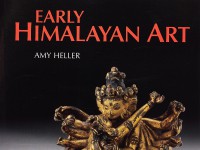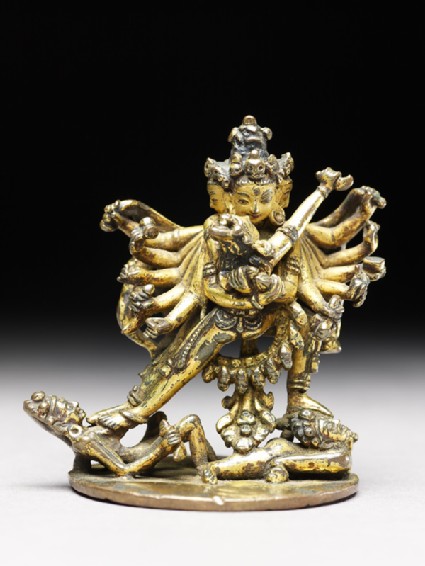Early Himalayan Art
A full catalogue of the Ashmolean's collection of diverse works from the formative periods of Himalayan art, c. AD 700-1400 by Amy Heller (published Oxford, 2008).

Publications online: 55 objects
- Reference URL
Actions
Figure of Samvara and his consort Vajravarahi
-
Literature notes
Samvara and his consort are depicted in close embrace. Samvara, whose Tibetan name Demchog (bde mchog) means ‘excellent bliss’, is immediately recognizable by his four faces and twelve arms, among which the uppermost arms stretch a flayed elephant skin over his shoulders as if it were a cape. His central hands hold the vajra and bell, symbols of dynamic energy and wisdom. This is an iconography specific to Samvara, who usually clasps as his consort the goddess Vajravarahi, the Vajra dakini with a sow’s head, holding the chopper and skull cup as does the female deity here. However, the sow’s head is not present, which suggests that this sculpture represents the Vajravilasini aspect of Vajravarahi. She holds the same attributes as Vajravarahi, but she is not wrathful. Her name is literally ‘amorous playfulness’, which corresponds well with the goddess represented here [1].
The principal faces of the male deity are all gentle in character, the almond eyes of the central face gazing directly at the goddess’s face, with a slight smile. At the back of his head, Samvara’s wrathful face is rather docile, although the eyes are more globular. Far from the frenzy of the protector deities made in Tibet, this Nepalese sculpture shows a delicacy both in expression and workmanship. The matt gold paint of the faces, however, indicates that this image was at one time worshipped in Tibet, since the application of such paint forms part of Tibetan consecration rituals.
The arrangement of arms is very successful, as they are cast at distinct angles so that they radiate quite evenly. The goddess raises the chopper with her right hand and with her left hand brings a skull cup to the lips of the ‘wrathful’ face at the back of the sculpture [2]. She appears to be nude save for crown, armbands and anklets, and the belt of bone and beads at her waist, which is draped around her hips. Samvara is dressed in identical fashion. The image is finished at the rear as regards their bodies, but the elephant skin draped from shoulders is merely a silhouette. The feet are placed on the head of a prostrate male with a squat, corpulent body holding a club, and on the chest of a taller figure whose gauntness makes a strong contrast with the other.
This distinctive position of trampling the shorter deity’s face, whose neck stretches backwards in a very elastic position, recalls a silver sculpture of Samvara (H. 16 cm), attributed to Khasa Malla workmanship of the thirteenth to fourteenth century [3]. There too the design of the bone apron falls at a height which accentuates the curves of the buttocks and the agility of the goddess’s legs as she clings around Samvara’s waist. However, the present image of Samvara does not show the emphasis of the joints of fingers and toes which characterize Khasa Malla sculptures. This tends to suggest that our Samvara is approximately of the same period, but produced in the Kathmandu Valley.
[Footnotes:]
1 English, Vajravarahi, p. 84.
2 The attributes held in the proper right hands are: top – elephant hide; 2 – damaru; 3 – empty; 4 – flower-bud on stem; 5 – empty; 6 – central pair; in the proper left hands: top – elephant hide; 2 – empty; 3 – skull cup; 4 – (partially broken) stem(?); 5 – group of heads; 6 – central pair.
3 Alsop, ‘The Metal Sculpture of the Khasa Malla Kingdom’, fig. 4. -
Details
- Associated place
- Date
- 13th - 14th century (1201 - 1400)
- Material and technique
- gilt bronze
- Dimensions
- 7.2 x 7 x 5.4 cm max. (height x width x depth)
- Material index
-
processed material › metal › gold,processed material › metal › alloy › copper alloy › bronze
- Technique index
-
covered › metallized › gilded
- Object type index
- No. of items
- 1
- Credit line
- Purchased, 1994.
- Accession no.
- EA1994.135
-
Further reading
Heller, Amy, Early Himalayan Art (Oxford: Ashmolean Museum, 2008), no. 10 on p. 64, illus. p. 65
Location
Objects are sometimes moved to a different location. Our object location data is usually updated on a monthly basis. Contact the Jameel Study Centre if you are planning to visit the museum to see a particular object on display, or would like to arrange an appointment to see an object in our reserve collections.
Galleries
Publications online
-

Early Himalayan Art
Samvara and his consort are depicted in close embrace. Samvara, whose Tibetan name Demchog (bde mchog) means ‘excellent bliss’, is immediately recognizable by his four faces and twelve arms, among which the uppermost arms stretch a flayed elephant skin over his shoulders as if it were a cape. His central hands hold the vajra and bell, symbols of dynamic energy and wisdom. This is an iconography specific to Samvara, who usually clasps as his consort the goddess Vajravarahi, the Vajra dakini with a sow’s head, holding the chopper and skull cup as does the female deity here. However, the sow’s head is not present, which suggests that this sculpture represents the Vajravilasini aspect of Vajravarahi. She holds the same attributes as Vajravarahi, but she is not wrathful. Her name is literally ‘amorous playfulness’, which corresponds well with the goddess represented here [1].
The principal faces of the male deity are all gentle in character, the almond eyes of the central face gazing directly at the goddess’s face, with a slight smile. At the back of his head, Samvara’s wrathful face is rather docile, although the eyes are more globular. Far from the frenzy of the protector deities made in Tibet, this Nepalese sculpture shows a delicacy both in expression and workmanship. The matt gold paint of the faces, however, indicates that this image was at one time worshipped in Tibet, since the application of such paint forms part of Tibetan consecration rituals.
The arrangement of arms is very successful, as they are cast at distinct angles so that they radiate quite evenly. The goddess raises the chopper with her right hand and with her left hand brings a skull cup to the lips of the ‘wrathful’ face at the back of the sculpture [2]. She appears to be nude save for crown, armbands and anklets, and the belt of bone and beads at her waist, which is draped around her hips. Samvara is dressed in identical fashion. The image is finished at the rear as regards their bodies, but the elephant skin draped from shoulders is merely a silhouette. The feet are placed on the head of a prostrate male with a squat, corpulent body holding a club, and on the chest of a taller figure whose gauntness makes a strong contrast with the other.
This distinctive position of trampling the shorter deity’s face, whose neck stretches backwards in a very elastic position, recalls a silver sculpture of Samvara (H. 16 cm), attributed to Khasa Malla workmanship of the thirteenth to fourteenth century [3]. There too the design of the bone apron falls at a height which accentuates the curves of the buttocks and the agility of the goddess’s legs as she clings around Samvara’s waist. However, the present image of Samvara does not show the emphasis of the joints of fingers and toes which characterize Khasa Malla sculptures. This tends to suggest that our Samvara is approximately of the same period, but produced in the Kathmandu Valley.
[Footnotes:]
1 English, Vajravarahi, p. 84.
2 The attributes held in the proper right hands are: top – elephant hide; 2 – damaru; 3 – empty; 4 – flower-bud on stem; 5 – empty; 6 – central pair; in the proper left hands: top – elephant hide; 2 – empty; 3 – skull cup; 4 – (partially broken) stem(?); 5 – group of heads; 6 – central pair.
3 Alsop, ‘The Metal Sculpture of the Khasa Malla Kingdom’, fig. 4.
Notice
Object information may not accurately reflect the actual contents of the original publication, since our online objects contain current information held in our collections database. Click on 'buy this publication' to purchase printed versions of our online publications, where available, or contact the Jameel Study Centre to arrange access to books on our collections that are now out of print.
© 2013 University of Oxford - Ashmolean Museum










